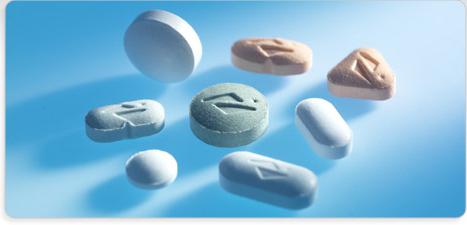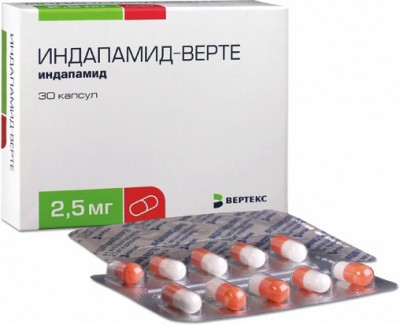Is it possible to lose weight by taking indapamide. The use of the substance indapamide.
Indapamide-Retard is a long-acting thiazide-like diuretic available in the form of film-coated tablets and capsules. The drug should be used 1 time per day, while for 24 hours there is a hypotensive effect. Indapamide-Retard has no effect on metabolic processes in the body and is generally well tolerated by patients. It is important to remember that there are a number of contraindications to the use of this medicinal product. Before use, read the instructions and consult a doctor.
The effect of the drug on the body
The active substance of the drug has a hypotensive prolonged effect on the patient's body. Tablets are able to block the reabsorption of chloride, hydrogen, sodium and potassium ions in the cortical segment of the distal tubule of the nephron and in the proximal tubules. The active substance of Indapamide is a sulfonylurea derivative, its structure resembles a diuretic. It is often used in complex therapy at arterial hypertension.
The drug gently acts on the body, gradually reducing pressure, while slightly increasing the number of urination. The drug has positive influence on the vessels. The active substance changes the permeability of membranes for minerals, due to this, the contractility of the elements decreases vascular wall.
Do not change the quantitative content of lipids in blood plasma. The drug reduces the sensitivity of the vascular walls to angiotensin I and norepinephrine, increases the rate of prostaglandin synthesis. At long-term use reduces the production of stable and free acid radicals. The hypotensive effect is observed after a week of daily use.
The main actions of Indapamide-Retard:
- hypotensive;
- vasodilating;
- diuretic.
Intensity hypotensive action depends on its ability to increase arterial compliance, reduce the total peripheral resistance of blood vessels and arterioles. Maximum effect lasts for a day after taking Indapamide at the recommended dosage of 2.5 mg. If the dosage is exceeded, the hypotensive effect does not increase, but this leads to an increase in urination and an increase in side effects.
The drug can be used in a course for 3 months, because it does not violate lipid and carbon metabolism. Indapamide is allowed to be prescribed to patients with one kidney and to patients with acute renal failure who are on hemodialysis. The drug can also be used:
- Patients with diabetes.
- People with increased level lipids in blood plasma.
- Patients with chronic renal failure.
The undoubted advantage of this drug are: low price, high efficiency, good tolerance.
The composition of the medicinal product
The active substance of the drug is indapamide hydrochloride. Also, the composition of the drug includes other excipients:
- lactose monohydrate;
- magnesium stearate;
- sodium lauryl sulfate;
- macrogol;
- titanium dioxide;
- food talc;
- crospovidone.
Taking medication at safe doses contributes to the reduction blood pressure.
Distribution in the body
The drug after administration is rapidly and completely absorbed from the gastrointestinal tract. There is a high bioavailability (more than 93%). Eating significantly slows down adsorption, but ultimately does not affect the absorption of the substance. The maximum concentration of substances in the blood plasma is observed 1-2 hours after taking the drug; in the retard form, the maximum is reached after 12 hours. At the same time, 75% of indapamide and 25% of its metabolites are in plasma.
The active substance comes into contact with plasma proteins, can be sorbed by erythrocytes, and also comes into contact with the elastins of the vascular wall. overcomes histohematic barriers, penetrates into breast milk. The drug is excreted mainly with urine (70%) and feces (no more than 22%). The half-life of the drug is about 18 hours. Metabolism takes place in the liver.
If you use the medicine in a course, there is an accumulation of its active substances in the body. Can be used to treat patients with renal insufficiency. However, in patients with hepatic insufficiency, long-term use of a diuretic may develop encephalopathy.
When and how is it applied
The medicinal product is prescribed for hypotension in such cases:
- For elderly patients.
- With isolated hypotension (when only blood pressure is elevated).
- Essential arterial hypertension.
- In patients with heart failure.
Indapamide-Retard is often prescribed in advanced cases hypertension, as part of complex therapy. The drug has a beneficial effect on work of cardio-vascular system prevents the development of heart attack and stroke.
The medicine should be taken every morning half an hour before meals. It is recommended to take a tablet enough water.
Contraindications and side effects
Any drug has contraindications for use, which should be read before taking the medicine, otherwise it can lead to disastrous consequences. Consider the most common side effects:
From the side of the central nervous system:
- nervousness, irritability;
- dizziness;
- headache, migraine;
- drowsiness, insomnia (depending on individual characteristics organism);
- tension;
- muscle spasm;
- palpitations, tachycardia.
From the side digestive system:
- nausea, vomiting;
- diarrhea, constipation;
- stomach ache.
With prolonged use, despite the appearance of side effects, the development of pancreatitis is possible. In some cases it is possible allergic reactions e.g. urticaria. Side effects when taking Indapamide occur quite rarely, but at their first manifestations, you should consult a doctor to determine the causes and replace the drug.
- pregnant and lactating mothers;
- at liver failure;
- patients with anuria;
- patients with low concentrations of potassium and magnesium in the blood;
- with individual intolerance or hypersensitivity to the individual components of the drug.
The drug is not prescribed to patients under 18 years of age. Very carefully, you can use the drug for violations of the water and electrolyte balance, at the decompensated stage of diabetes mellitus. When taking cardiac glycosides and laxatives, it is necessary to regularly monitor the concentration of potassium ions and the level of creatinine.
Patients with diabetes need to regularly monitor the level of glucose in the blood, especially with hypokalemia. Frequent urination in some cases can lead to the formation of acute renal failure. In order to prevent this, it is necessary to compensate for the loss of fluid in the body. If it is necessary to undergo a long course of treatment with this drug, kidney function should be monitored.
Analogues
Diuretics are popular in the treatment of hypertension. Their action is to increase urination, reduce vascular tension, thereby reducing the volume of circulating blood. There are many drugs with the same active ingredient. They differ among themselves by manufacturing companies, price and, in some cases, excipients. It is necessary to list the main drugs, the active substance of which is indapamide:
- Indap.
- Acrypamide.
- Arindap.
- Ravel.
To a greater extent, they differ from each other only in price. Of course, you should not replace the prescribed drug with its analogues on the advice of friends or by reading information on the Internet. Before use, a doctor's consultation is necessary.
Despite the fact that Indapamide has a number of contraindications and side effects, it is very effective tool to reduce pressure. It is quickly and completely absorbed. The undoubted advantage is that with prolonged use of the drug, there is therapeutic effect which persists for several months.
Designed for people suffering from high blood pressure. The drug and the active substance have the same name. Such drugs as Ravel, Arifon are considered analogues of this medicine.
How this drug affect blood vessels? First of all, under the influence of Indapamide, the vessel walls become less sensitive to angiotensin and have the effect of constricting arterioles and arteries. In addition, after taking it, substances that are responsible for the normal lumen of blood vessels begin to be more actively produced. The concentration of calcium ions, which contains smooth muscle, decreases, so vascular tone returns to normal.
The drug has a slight diuretic effect. If you characterize the main property of the drug, hypotensive, then it is considered gradual. The action of Indapamide begins only when blood pressure exceeds the norm.
The effect becomes pronounced when the drug is used daily for twenty days. Moreover, if the dose is increased, the pressure will decrease to a greater extent, but the diuretic property is also more active. The drug is prescribed for patients with heart failure and hypertension.
Indapamide tablets may have a prolonged release or slow release. The instructions indicate that the dose of the drug, if it is not a prolonged form, is two and a half milligrams daily. The manufacturer also points out that when increasing the dose, you need to know that side effects are more likely to occur, and not a more significant decrease in pressure.
Indapamide can be prescribed both in the form of complex therapy, and as an independent drug. This drug should be considered in patients with kidney disease. In the case when one kidney is removed, and the patient is on hemodialysis.
The drug Indapamide is contraindicated if there is an individual intolerance, as well as in case of violation cerebral circulation, in the presence of severe dysfunction of the liver and kidneys. The drug is not prescribed if there is a decompensated form of diabetes,. Indapamide should not be taken if the patient is taking other heart medications that prolong QT time. Pregnancy and lactation are also a contraindication.
Side effects and overdose of Indapamide
First of all, it must be taken into account that the occurrence of side effects is most often due to a high dose. medication taken. This medicine is a drug systemic action, therefore, in case of an overdose, it can have negative impact on the state of any group of organs.
Overdose may result in significant reduction blood pressure. Fluid is lost, disturbances in the work of the gastrointestinal tract, nervous system occur, problems with electrolyte balance arise. The patient needs to wash the stomach and take sorbents (
The drug "Indapamide" acts on the vascular walls, relaxing them and normalizing the elasticity of the muscles. Thanks to this drug, arterioles increase, which leads to the unhindered movement of blood in the body. Tablets "Indapamide" - This is a vasodilator, pharmacodynamically similar to a thiazide diuretic. During the day, the amount of urine produced increases slightly. Together with it, the predominant ions of sodium, chlorine, and potassium are removed from the body. While taking the drug, carbohydrate and fat metabolism remain normal, which makes it possible for patients suffering from obesity or diabetes to take the drug. With a pronounced increase in the left ventricle of the heart, the drug "Indapamide" significantly reduces the level of hypertrophy. With regular use of the drug, the effect is achieved after 2 weeks, and after 10 weeks, the maximum beneficial effect is noted. A single dose of the drug "Indapamide" saves therapeutic property up to 24 hours.
Pharmacokinetics
The pressure drug "Indapamide" is rapidly absorbed into gastrointestinal tract and is excreted primarily in the urine. The content of inactive metabolites in feces is about 20%. The diuretic interacts with plasma and red blood cells, penetrates into breast milk. With regular use of the drug, cumulation was not observed. Patients with hepatic impairment should use caution this medicine, to avoid the formation
Indications for use
What does the medicine "Indapamide" help from? Indications for its use are:
- Arterial hypertension.
- (sodium and water retention in the body).

Contraindications
The drug is limited to the following diseases:
- Liver dysfunction.
- Impaired kidney function.
- Intolerance to the components of the drug.
- Hypokalemia.
- Violation of blood circulation in the system of the brain and spinal cord.
- Gout.
In what cases can there be complications with the use of the drug "Indapamide"
- Lactose intolerance.
- Pregnancy and lactation.
- Age up to 18 years.
- Unstable water and electrolyte balance.
Method of application, dosage

The drug is taken orally 1 time per day, 2.5 mg. Morning intake is more effective because a large number of food slows down the absorption of the drug. Tablets should be swallowed without chewing, drinking plenty of water. An increase in the dose of the drug "Indapamide" does not lead to an acceleration therapeutic action, but causes a number of side effects. Patients suffering from heart failure, in the absence of improvement, are prescribed a dose of 5 mg per day.
Adverse reactions
When taking the drug "Indapamide" (from which it is prescribed, we already know) a side effect may occur. First of all, this happens when using an increased dose of the drug, intolerance to the substance by the body, the impact of individual components on a specific organ system. Side effects can manifest themselves in different ways.
- Central nervous system: headache, drowsiness, asthenia, insomnia, irritability.
- Respiratory system: pharyngitis, acute cough.
- Digestive system: nausea, vomiting, diarrhea.
- Urinary system: nocturia, infectious inflammations.
- Cardiovascular system: arrhythmia, palpitations, hypokalemia.
- Skin diseases: itching, urticaria, rash.
Price
The average price of the drug "Indapamide" in Russia is 12 rubles. The package contains 30 tablets of 2.5 mg.
Interaction with other drugs

Anti-inflammatory drugs reduce the effect of the drug "Indapamide", quickly consume fluid in the body, which is why it has to be constantly replenished. When taking Indapamide tablets, what determines the compatibility with other drugs? The composition of the diuretic is quite complex, therefore complex treatment is selected by a specialist strictly individually, based on the prescribed drugs.
- Preparations containing lithium are rapidly excreted in the urine, so it is necessary to control the level of the substance in the blood serum.
- GCS, on the contrary, retain water in the body, reducing the antihypotensive effect.
- reduce the amount of potassium in the body, which can lead to hypokalemia.
- Calcium: an increase in the content of salts in the body.
- Radiopaque preparations containing a significant amount of iodine can lead to the development of renal failure.
- cause the risk of orthostatic hypotension.
special instructions
Which patients need careful monitoring of their condition while taking the drug "Indapamide"? What do they need to watch out for? Patients with cirrhosis of the liver, heart, kidney, liver failure are required to undergo treatment with the drug "Indapamide" strictly under the supervision of doctors. Possible appearance dehydration in the body leads to an exacerbation of organ dysfunction. It is important to control the fluid content in the body and compensate for it in time.
The diuretic drug "Indapamide" is able to effectively reduce blood pressure. At the same time, normalization occurs gently, and the diuretic effect is minimal. The drug has cumulative properties. The maximum result is observed after 8-10 weeks after the start of use. The medication has a list of contraindications and side effects. To prevent the latter, you should consult a doctor and carefully monitor your well-being.
Composition, properties and form of release
Tablets "Indapamide" belong to the group of diuretics and drugs for hypertension. The main actions include a smooth decrease in pressure. At the same time, the diuretic effect is controllable, which helps prevent dehydration and maintains a normal balance of substances. Externally, the tablets are white or slightly grayish in color, round, film-coated. The action of "Indapamide Retard" is due to the presence active substance indapamide. The pills contain 2.5 mg of the drug. The tablets also contain:
Mechanism of action
 The drug effectively lowers blood pressure.
The drug effectively lowers blood pressure. The action of "Indapamide" on the body is based on the increased excretion of elements of sodium and chlorine from the blood. In this case, the drug has practically no effect on the concentration of potassium and magnesium. As a result, there is a decrease in blood pressure and a slight diuretic effect is observed. The value of the reduced pressure does not depend on the quantity accepted remedy. As the dose increases, the amount of liquid released changes. The medicine is characterized by a cumulative effect. If you constantly take "Indapamide" for 8-12 weeks, then the maximum result from the treatment is achieved.
Enter your pressure
Move the sliders
Why is Indapamide prescribed?
Indications for use describe situations in which the use of the remedy brings maximum benefit and result. The diuretic drug is widely used for high blood pressure. Assign "Indapamide" as an independent tool or as an addition to complex therapy. If the patient does not have hypertension, taking pills causes a deterioration in the condition and manifestations adverse reactions.
Instructions for use and dosage
 During treatment, it is recommended to follow the doctor's prescriptions according to the instructions.
During treatment, it is recommended to follow the doctor's prescriptions according to the instructions. Drink diuretics should be strictly according to the schedule indicated by the doctor. "Indapamide" can be taken before or after meals. For high blood pressure, 1 tablet in the morning is recommended. In the evening, the medicine is not taken, since "Indapamide" refers to diuretic medicines. If necessary, it is allowed to drink a pill a small amount liquids. The result begins to appear no earlier than 2-3 weeks after the start of therapy. It has to do with cumulative action. If the duration of use exceeds 4-5 weeks, but there is no effect, the drug should be discontinued or reconsidered. daily dosage.
Use during pregnancy and lactation
"Indapamide" from pressure should be taken according to the doctor's recommendations. In this case, all risk factors should be taken into account. These include the period of gestation. Taking the drug in this case is dangerous. "Indapamide" during pregnancy has the ability to penetrate the placenta to the fetus. At the same time, the diuretic reduces blood pressure and provokes oxygen starvation. Instructions for use prohibits the use of a diuretic during breastfeeding. "Indapamide" is harmful to infants, as it penetrates into mother's milk. If a woman needs to take the remedy, then for the duration of therapy, feeding is replaced with artificial.
Is it for children?
 The drug is not recommended for children, there is a risk of lowering blood pressure.
The drug is not recommended for children, there is a risk of lowering blood pressure. The use of "Indapamide" to a child in the presence of the disease is not recommended. It is forbidden to use due to the lack of experimentally confirmed evidence of the safety of the product. Application can provoke cases low pressure in a minor patient. In case of illness, it is better to resort to alternative drugs. There is an option to use the remedy every other day with a minimum daily dose and with high blood pressure.
Contraindications
"Idapamide" drink with caution at the beginning of treatment. This is due to the presence of a list of prohibited diseases. The consequence of ignoring the list are obvious side effects. Over time, they develop into health complications. Do not use at low pressure and gout. Among other contraindications to taking "Indapamide tab":
- negative reactions to the composition;
- age up to 18 years;
- taking incompatible drugs;
- circulatory disorders in the brain;
- urinary disorders;
- kidney failure;
- low levels of potassium in the body.
How to understand what an overdose?
 An overdose of the drug can cause weakness in the body, drowsiness and disturbances in the digestive tract.
An overdose of the drug can cause weakness in the body, drowsiness and disturbances in the digestive tract. Taking the medicine for a long time without the supervision of a doctor or with violations of the prescribed dosages is fraught with the onset of an overdose. Long-term use with disorders is characterized by nausea, hypotension, weakness, drowsiness and disturbances in the work of the stomach. In this case, the balance of substances in the body is quickly disturbed. If you stop and start using the drug correctly, taking into account the prescribed dosage, you can avoid dangerous consequences. It is possible to reduce the concentration of indapamide in the blood by washing. Acts similarly Activated carbon or other sorbents.
Pharmachologic effect:Diuretic agent. Indapamide is a substance resembling a thiazide diuretic in structure. It is a sulfonylurea derivative. It is used in the treatment of arterial hypertension.
Due to the peculiarities of the mechanism of action, the product causes a decrease in blood pressure without a significant effect on the volume of urination. The point of application of the action of Indapamide is the vessels and renal tissue. Due to the high lipophilicity, Indapamide changes the permeability of membranes for calcium, resulting in a decrease contractility smooth muscle elements of the vascular wall.
The product also stimulates the formation of vasodilators and blockers of platelet aggregation: prostacyclin PgI2 and prostaglandin PgE2. As a result of the action of the product, there is a decrease in the total precardiac load, dilation of arterioles and a decrease in blood pressure. AT renal tissue at the level of the cortical layer, the product reduces the ability to reabsorb sodium, increases the excretion of magnesium, potassium and chlorine in the urine, thereby increasing the volume of excreted fluid. The effect on the release of magnesium and potassium is not cardinal. The hypotensive effect of Indapamide is noticeable at dosages that do not cause a significant increase in diuresis. Therefore, taking the drug in therapeutic doses causes only a hypotensive effect without a significant increase in the volume of urine excreted.
Has no effect on lipid metabolism(triglycerides, high and low density lipoproteins), carbohydrate metabolism, including in patients with diabetes mellitus. Against the background of taking the product, a decrease in the severity of left ventricular hypertrophy is observed. The hypotensive effect of Indapamide is found even in patients on chronic hemodialysis.
Absorbed from digestive tract quickly and completely. Eating at the same time as the product slows down the rate of absorption, but does not change the content of the absorbed substance. An improved release form (tablets with prolonged action) provides a uniform release of indapamide at an active substance content of 1.5 mg, which improves the effectiveness of 24-hour blood pressure control.
Maximum plasma concentration indapamide is determined after 12 hours. In the case of repeated administration of the next dose of the product, significant changes in plasma concentration are reduced.
The elimination half-life is approximately 18 hours (14 to 24 hours). Binds to plasma proteins over 79%. Steady-state is determined after 7 days with regular use. Metabolized in hepatocytes, eliminated by the kidneys (as inactive metabolites) - within 70% of taken dose, 22% - with feces.
In moderate renal failure, pharmacokinetic parameters do not change.
Indapamide route of administration and dosage:
It is prescribed in the morning, 1 tablet every day orally. Swallow without chewing. Drink water. An increase in the dosage of Indapamide does not increase the hypotensive effect, but increases the diuretic effect.
Indapamide contraindications:
Severe violations hepatic functions, including hepatic encephalopathy;
renal failure in the presence of anuria;
allergic reactions to indapamide and other components of the product;
gout;
age up to 18 years;
pregnancy and lactation;
acute or recent cerebrovascular accident;
combination with products that cause an increase Q-T interval(eg cisapride);
hypokalemia.
Indapamide side effects:
From the side of the central and peripheral nervous system: paresthesia, fatigue, vertigo, headache, weakness, muscle pain - often.
Hematopoietic system: leukopenia, aplastic anemia, thrombocytopenia, agranulocytosis, hemolytic anemia- not very often.
From the side of the cardiovascular system: hypotension, cardiac arrhythmias - very rarely.
Laboratory parameters: a decrease in the concentration of potassium in the blood serum, especially often hypokalemia develops with contributing factors risk; decrease in sodium concentration, leading to dehydration of the body or hypovolemia, orthostatic reactions are possible; hypochloremia can provoke metabolic alkalosis; an increase in calcium concentration (very rarely); an increase in uric acid.
From the digestive system: dry mouth, nausea, constipation - not often; liver dysfunction, pancreatitis - very rarely; with liver failure, there is a risk of developing hepatic encephalopathy.
Immune system: allergic reactions, especially in persons with hypersensitivity to other products: purpura, maculopapular rash, exacerbation of systemic lupus erythematosus.
From the side respiratory system: sinusitis, cough, pharyngitis - not often.
Pregnancy:
The use of diuretics, including Indapamide, is unjustified from a pathogenetic point of view in the treatment of edema and arterial hypertension during pregnancy. Taking Indapamide can cause insufficiency of placental-fetal blood flow with the development of fetal malnutrition. It is not recommended to prescribe the product during pregnancy. If the product is to be taken during lactation, breast-feeding stop because active substance passes into breast milk.
Overdose:
Indapamide is toxic when taken at a dosage of 40 mg (27 times the therapeutic single dose). Signs of overdose: vomiting, nausea, hypotension, drowsiness, dizziness, oliguria or polyuria, anuria due to severe hypovolemia is possible. Symptoms of overdose are due to electrolyte and water disturbances(hypokalemia, hyponatremia). Indapamide can be eliminated by gastric lavage, the use of enterosorbents (activated charcoal). Effective rehydration and restoration of electrolyte balance. Further - symptomatic treatment. Treatment should be carried out in stationary conditions.
Use with other medicinal products:
Salicylates in large doses and systemic non-steroidal anti-inflammatory drugs have a negative effect on the effectiveness of the antihypertensive effect of the product. When prescribed to patients with dehydration, acute renal failure may develop (in this case, it is necessary to replenish the fluid balance).
In combination with products containing lithium salts, there is an increase in the concentration of lithium in the blood due to a decrease in lithium excretion. This may contribute to the symptoms of an overdose of a lithium-containing product. If such a combination is justified, then it is necessary to control the level of lithium in the blood.
Under the influence of the systemic action of tetracosactide and glucocorticosteroids, the hypotensive effect of Indapamide is leveled due to the retention of sodium and water ions in the body.
Mineral and glucocorticosteroids, amphotericin, laxatives with a mechanism of action due to increased intestinal motility provoke hypokalemia. If such a combination is used - for timely diagnosis hypokalemia requires monitoring of potassium in the blood serum.
The combination with potassium-sparing diuretics (spironolactone, triamterene, amiloride) causes, especially in patients with renal insufficiency or diabetes, hyperkalemia.
In patients with signs of dehydration, the combination of indapamide with angiotensin-converting factor inhibitors may cause renal failure (due to hyponatremia) and sudden a sharp decline blood pressure. When switching from Indapamide to angiotensin-converting factor inhibitors, the diuretic should be discontinued 3 days before the planned therapy.
When combining Indapamide with cardiac glycosides, there is a high risk of toxic effects in the aftermath. For timely diagnosis of the disorder, it is necessary to monitor the ECG parameters and the content of potassium in the blood serum.
The combination of indapamide with metformin can provoke the development of lactic acidosis due to the occurrence of renal failure.
It is not recommended to combine indapamide with bepridil, astemizole, erythromycin, pentamidine, sotalol, halofanthrinos, quinidine, sultopride, hydroquinidine, disopyramide, vincamine, amiodarone, terfenadine, bretilium, as torsade de points may occur. Harbingers of the development of torsade de points are the prolongation of the P-Q interval, a decrease in heart rate, and hypokalemia. Torsade de points - ventricular polymorphic tachycardia according to the "pirouette" variant - can provoke ventricular fibrillation.
With the introduction of a radiopaque substance while taking Indapamide, the likelihood of developing kidney failure increases. To prevent complications, hydration is necessary before the introduction of a radiopaque agent.
At simultaneous reception calcium salts, hypercalcemia is possible. Potentiation of the hypotensive action of Indapamide is observed when taking antipsychotics, imipramine and other tricyclic antidepressants. This can cause orthostatic hypotension. While taking Indapamide with cyclosporine, an increase in blood creatinine is possible. The combination with estrogen-containing products leads to the leveling of the hypotensive effect of Indapamide due to water retention in the body.
Release form:
Tablets with prolonged action of 1.5 mg. There are 30 tablets in a pack.
Storage conditions:
At normal conditions. The storage period is indicated on the pack. Released by prescription from a doctor.
Synonyms:
Acripamide retard (Akripamide), Arifon retard (Arifon), Indap, Arindap, Indapamide retard (Indapamide), Indapamide Nycomed, Vero-Indapamide, Indapamide MV, Indapamide-Vero, Indapamide Polpharma, Indapamide-Verte, Indapsan, Indapamide, Indapam, Ionic retard (Ionic), Tenzar, Ipres long, Indapamide SR, Lorvas, Leskoprid, Pamid, Retapres, Ravel SR, Frantel.
Indapamide composition:
Active substance: indapamide.
Inactive ingredients: copovidone, lactose monohydrate, magnesium stearate, hypromellose, colloidal anhydrous silica.
Additionally:
Hypokalemia 3.4 mmol or less enhances the toxic effects of cardiac glycosides and contributes to the occurrence of arrhythmia. In sick high risk these complications (malnutrition, heart failure, elderly age, liver cirrhosis, reception a large number medicinal products) it is necessary to systematically monitor the level of potassium in the blood serum and, if necessary, correct it.
Before the appointment of Indapamide, laboratory examination patient, especially in the presence of conditions that can provoke fluid and electrolyte disturbances. During the entire intake of the product, it is necessary to periodically monitor the content of electrolytes (sodium, potassium, magnesium) in the blood serum, as well as the level of glucose, pH, residual nitrogen and uric acid. Particular attention is paid to patients with ischemic disease heart, chronic cardiovascular insufficiency and cirrhosis of the liver, which is accompanied by ascites or edema, since such patients are at high risk of developing hepatic encephalopathy and metabolic alkalosis.
The high-risk group also includes patients with prolongation of the QT interval on the ECG of any origin (acquired or congenital). The development of bradycardia or tachycardia can lead to serious violations heart rate and torsades de pointes with lethal outcome.
The determination of the concentration of potassium in the blood serum must be carried out before the start of treatment, and against the background of taking Indapamide - more than once during the course of treatment.
Against the background of taking the product, an exacerbation of SLE (systemic lupus erythematosus) can be observed.
Prescribed with caution when diabetes, renal and hepatic insufficiency, hyperuricemia.
Severe dehydration can lead to the formation of acute renal failure due to a decrease in glomerular filtration. In such patients, the lack of fluid is replenished and renal functions are monitored at the beginning of therapy.
At the beginning of taking the product, secondary hypovolemia may occur as a result of sodium and water losses, which leads to a decrease in the level of glomerular filtration. As a result, there may be an increase in serum urea and creatinine concentrations. As a rule, such transient renal failure of a functional nature does not have negative consequences with normal renal functions, however, with the already existing insufficiency, the severity of the initial clinical picture may get worse.
Ingestion of the product by athletes may be the cause of a false positive reaction during doping controls. If hypercalcemia develops while taking Indapamide, this indicates a previously undiagnosed hyperfunction thyroid gland(hyperparathyroidism).
Before surgical treatment the patient should inform the anesthesiologist that he is taking indapamide.
Indapamide is not prescribed to children and adolescents under 18 years of age, since the experience of using the product in this age group so far missing.
The drug can cause hepatic encephalopathy with concomitant liver failure. If hepatic encephalopathy is suspected, the product should be discontinued immediately. Elderly patients may experience high susceptibility to the product, even if they are prescribed the usual dosage.
While taking the product, care must be taken when exercising potentially dangerous species activities, and the management of vehicles, i.e. work that requires increased concentration and increased speed psychomotor reactions.
Attention!
Before using the medication "Indapamide" you need to consult a doctor.
The instructions are provided solely for familiarization with " Indapamide».




